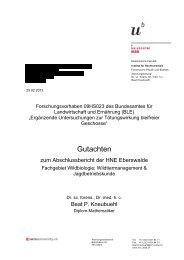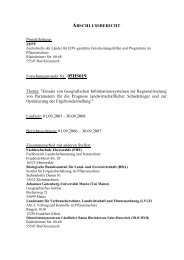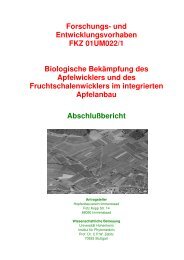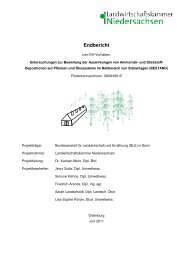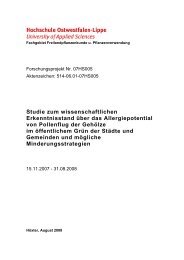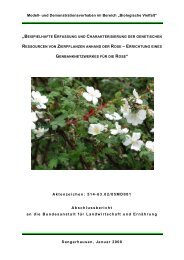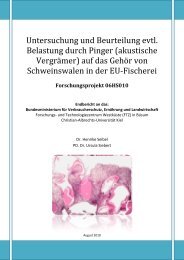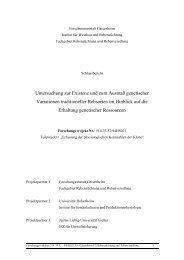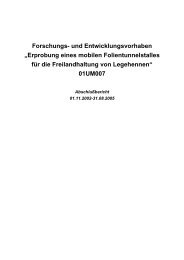Abschlussbericht Projekt: „Verminderung der ... - BLE
Abschlussbericht Projekt: „Verminderung der ... - BLE
Abschlussbericht Projekt: „Verminderung der ... - BLE
Erfolgreiche ePaper selbst erstellen
Machen Sie aus Ihren PDF Publikationen ein blätterbares Flipbook mit unserer einzigartigen Google optimierten e-Paper Software.
tubers to some extent (Heinecke 2007). During blackspot formation malnutrition related to<br />
Se, K, Mg and/or Fe deficiency may promote further spontaneous oxidation and polymerisation<br />
of substrates catalysed by the enzyme PPO generating dopaquinone. Free tyrosine,<br />
cystein, chlorogenic acid and caffeic acid are PPO specific substrates present in potato tubers<br />
(Dean et al. 1993; Kirk et al. 2006). The amount of these substrates might be restricted<br />
or decreased at an optimal supply of K (McNabnay et al. 1999), B (Mondy and Munschi<br />
1993), Se (Munshi et al. 1990) and Fe (Bergmann 1993). Despite the fact that a well balanced<br />
Fe concentration might mitigate blackspot susceptibility Fe also forms a complex<br />
with phenolic substances like chlorogenic acid esters during the cooking process of potato<br />
tubers causing after cooking darkening (Muneta and Kaisaki 1983; Griffiths and Bain<br />
1997). Nevertheless, malnutrition associated with K, B, Se and/or Fe deficiency might increase<br />
substrate concentrations and, therefore, stimulate the continuing non-enzymatic polymerization<br />
reaction with nucleophilic amino acid residues of proteins and form the black<br />
nitrogen containing pigment melanin (Dean et al. 1993; Kirk et al. 2006). Depending on<br />
the compounds intermediates with varying colours occur (Dean et al. 1993; Kirk et al.<br />
2006). With the present study we payed attention to the above described relationships between<br />
nutrient concentrations and blackspot susceptibility of potato tubers and investigated<br />
the effect of fertilizer on tuber quality when nutrients applied in amounts close to the requirement<br />
for producing optimal yield.<br />
Material and methods<br />
Material. Eight cultivars of table potatoes (Adretta, Afra, Gala, Granola, Lolita, Marabel,<br />
Nicola and Renate) were grown on sandy soils near Dethlingen, Germany, during two<br />
vegetation periods in 2006 and 2007. Conventional farming methods were practiced, including<br />
proper irrigation, adequate fertilization (urea and ammonium nitrate solution,<br />
diammonium phosphate as well as fertilizer combinations of KCL + Mg and K 2 SO 4 + Mg<br />
were applied) and an integrated pest management. To evaluate cultivar specific differences<br />
tubers of similar size from 40 to 50 mm and corresponding specific gravities were consi<strong>der</strong>ed.<br />
Analyses were performed in tubers harvested two weeks before usual harvest time<br />
(pre-harvest) and in tubers reaped during ideal time of harvest as well as in tubers stored<br />
for five and eight months, respectively, at 4°C and 95 % relative humidity. Furthermore,<br />
the samples were divided into two parts. Tubers from the first part were used to determine<br />
their blackspot index (BSI). Those of the second part were sliced, shock-frozen in liquid<br />
nitrogen, lyophilized (Epsilon 2-40, Christ) and ground to 50 mm using a micro hammer<br />
mill (Culatti AG, Switzerland) to analyse the concentrations of Se, B, Fe, Ca, Mg, P and K,<br />
respectively.<br />
Analyses. Blackspot index (BSI) of whole potato tubers of different specific gravities was<br />
determined according to the method proposed by the “Bundessortenamt” (BSA, Fe<strong>der</strong>al<br />
Plant Variety Office, Germany). The tubers were cooled down to 4 to 5°C and mechanical<br />
treated for 50 s in a vegetable washing machine with a rotating drum (Flott 18 K, Flottwerk<br />
166




